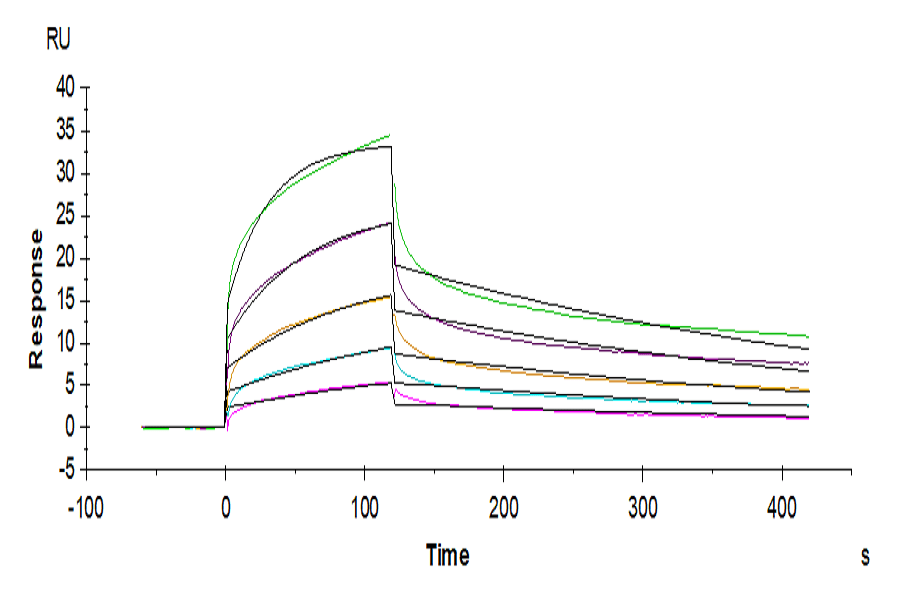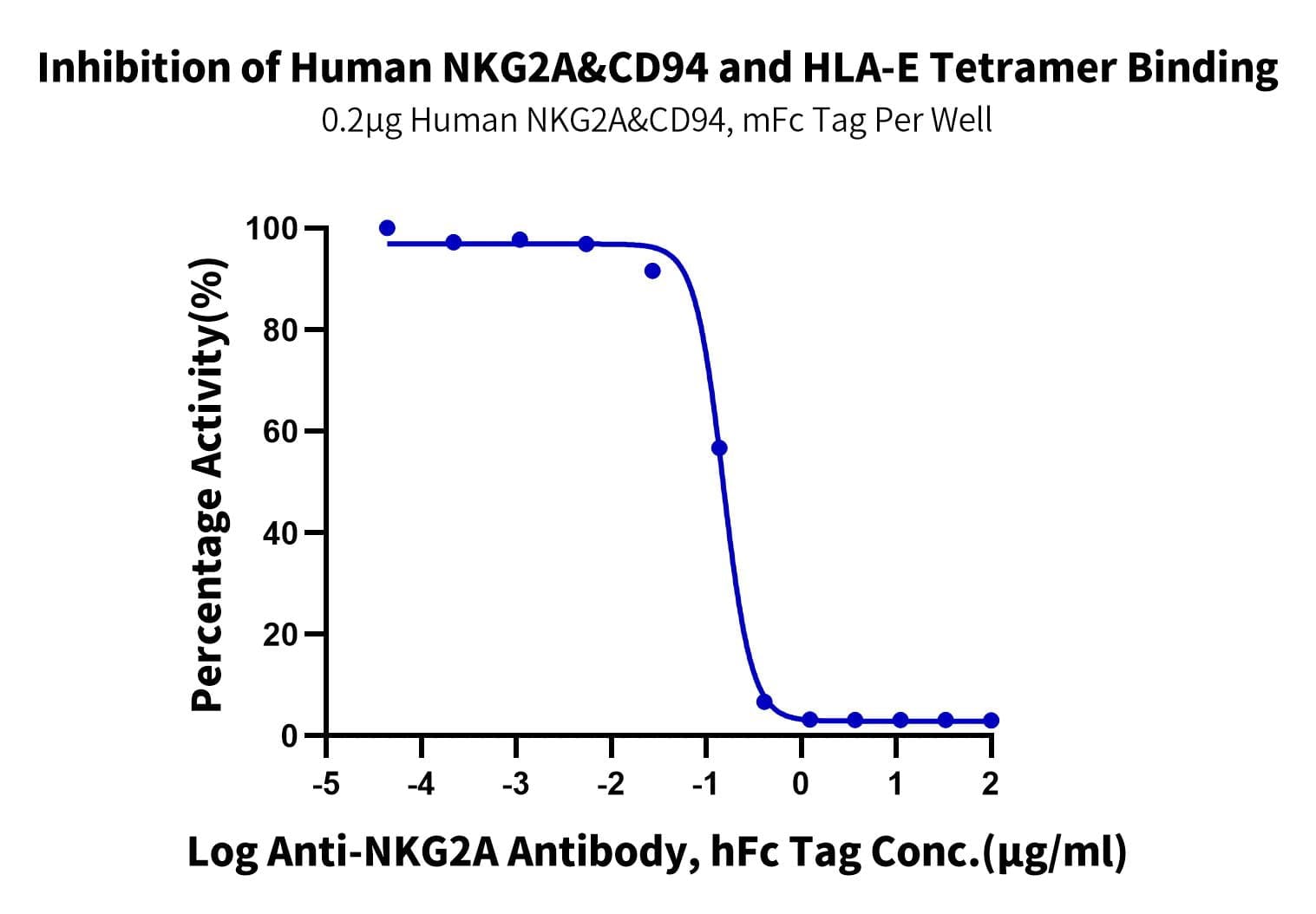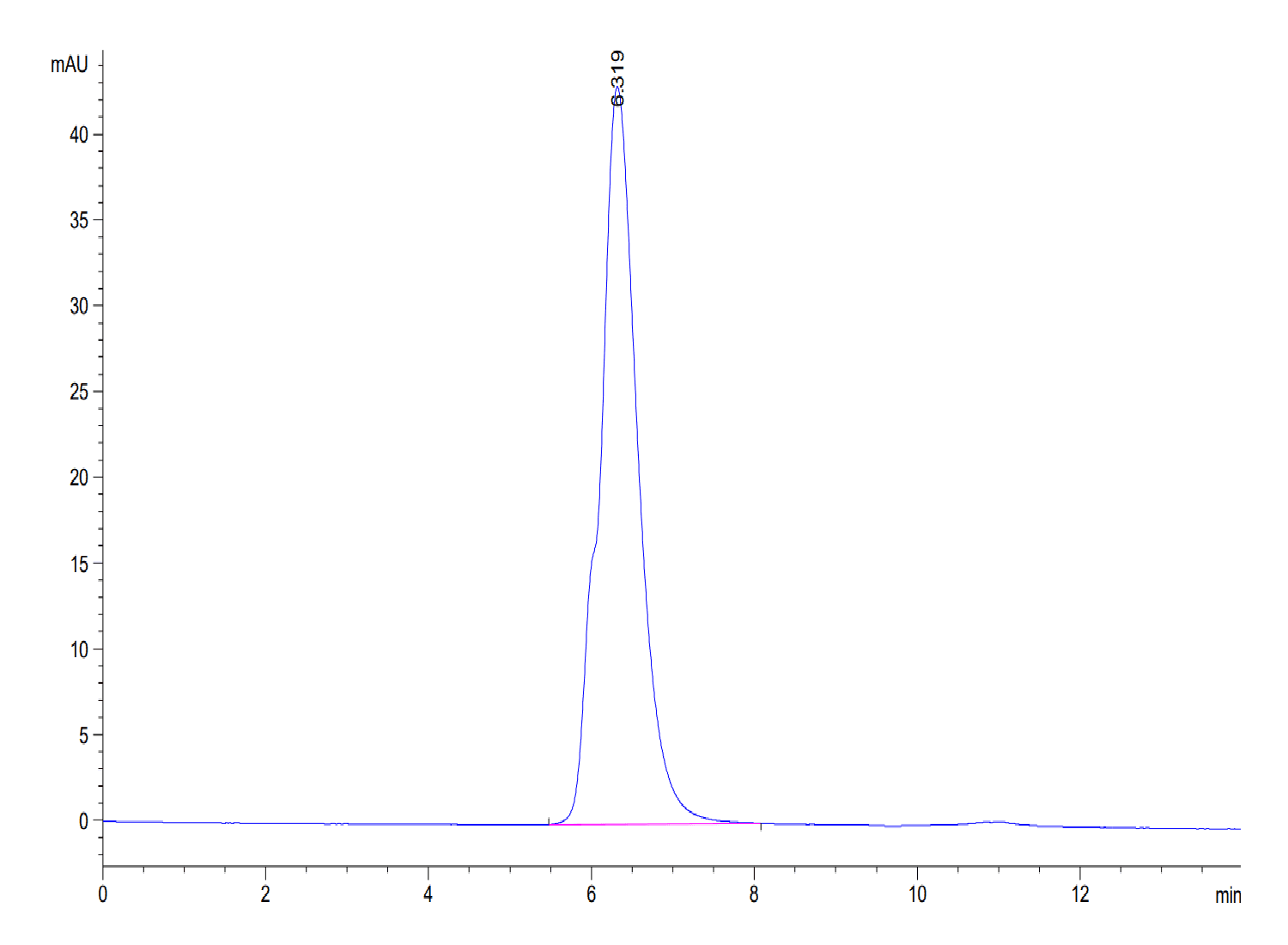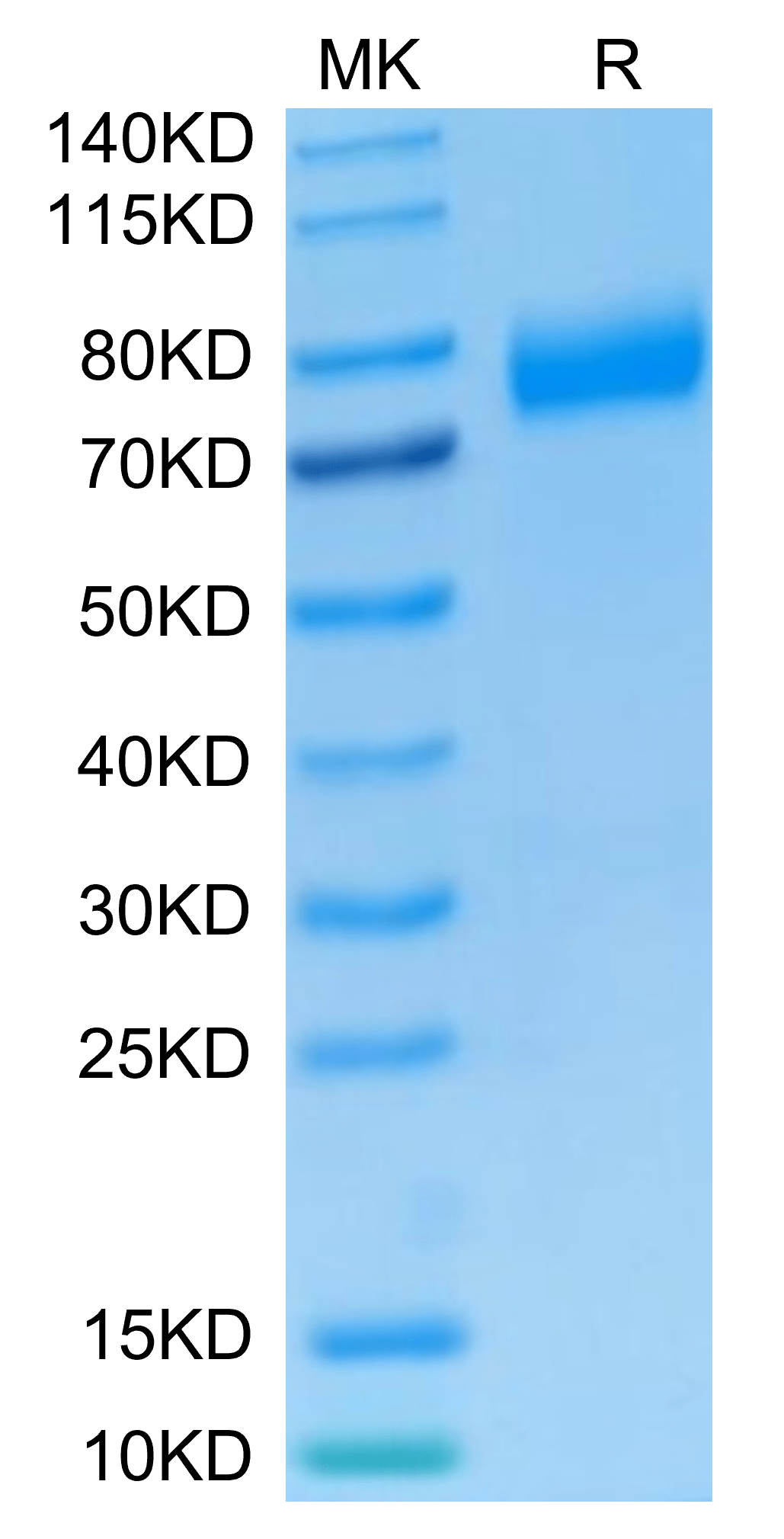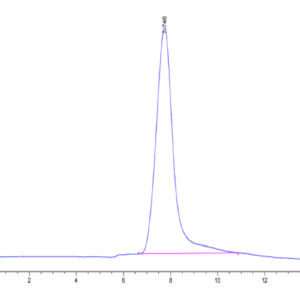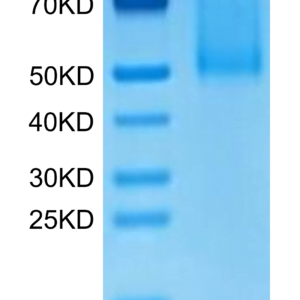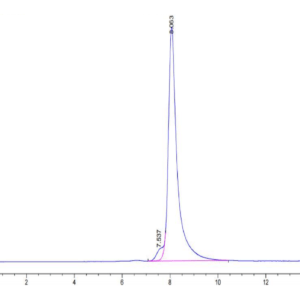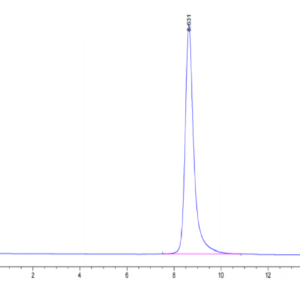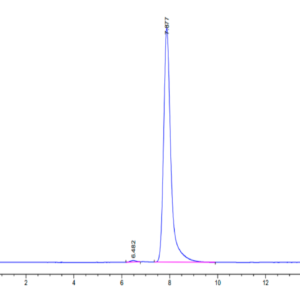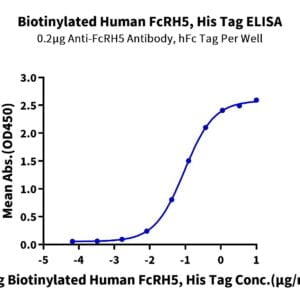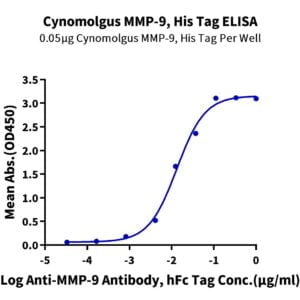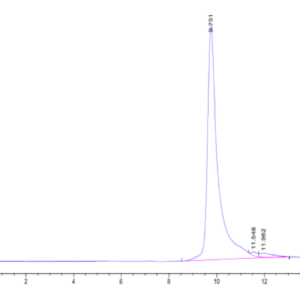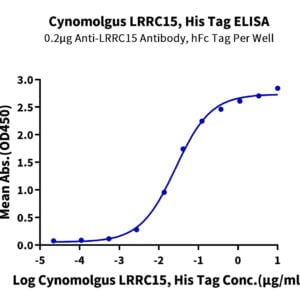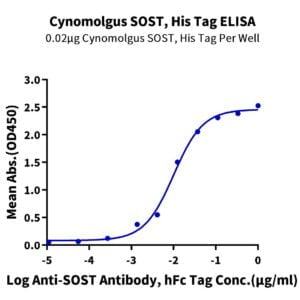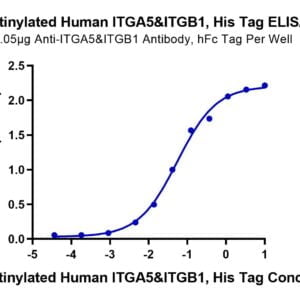| Weight | 1 lbs |
|---|---|
| Dimensions | 9 × 5 × 2 in |
| accession | P26715(NKG2A)&&Q13241(CD94) |
| express system | HEK293 |
| product tag | C-mFc |
| purity | > 95% as determined by Tris-Bis PAGE;> 95% as determined by HPLC |
| background | The ligand-receptor assignment between HLA-G and NKG2A/CD94 is dependent of the amino acid composition in the HLA-G heavy chain. Understanding the biophysical basis of receptor-mediated events that lead to NK cell inhibition would help to remove non-tumor reactive cells and support personalized mild autologous NK cell therapies. |
| molecular weight | The protein has a predicted MW of 56.9 kDa. Due to glycosylation, the protein migrates to 70-90 kDa based on Tris-Bis PAGE result. |
| available size | 100 µg, 500 µg |
| endotoxin | Less than 1EU per μg by the LAL method. |
Human NKG2A&CD94 Protein 4822
$330.00 – $1,100.00
Summary
- Expression: HEK293
- Functional: Yes (binding assay)
- Amino Acid Range: Arg100-Leu233(NKG2A) & Ser34-Ile179(CD94)
Human NKG2A&CD94 Protein 4822
| protein |
|---|
| Size and concentration 100, 500µg and lyophilized |
| Form Lyophilized |
| Storage Instructions Valid for 12 months from date of receipt when stored at -80°C. Recommend to aliquot the protein into smaller quantities for optimal storage. Please minimize freeze-thaw cycles. |
| Storage buffer Shipped at ambient temperature. |
| Purity > 95% as determined by Tris-Bis PAGE |
| target relevance |
|---|
| The ligand-receptor assignment between HLA-G and NKG2A/CD94 is dependent of the amino acid composition in the HLA-G heavy chain. Understanding the biophysical basis of receptor-mediated events that lead to NK cell inhibition would help to remove non-tumor reactive cells and support personalized mild autologous NK cell therapies. |
| Protein names NKG2-A/NKG2-B type II integral membrane protein (CD159 antigen-like family member A) (NK cell receptor A) (NKG2-A/B-activating NK receptor) (CD antigen CD159a) |
| Gene names KLRC1,KLRC1 NKG2A |
| Mass 26314Da |
| Function Immune inhibitory receptor involved in self-nonself discrimination. In complex with KLRD1 on cytotoxic and regulatory lymphocyte subsets, recognizes non-classical major histocompatibility (MHC) class Ib molecule HLA-E loaded with self-peptides derived from the signal sequence of classical MHC class Ia molecules. Enables cytotoxic cells to monitor the expression of MHC class I molecules in healthy cells and to tolerate self (PubMed:18083576, PubMed:37264229, PubMed:9430220, PubMed:9486650). Upon HLA-E-peptide binding, transmits intracellular signals through two immunoreceptor tyrosine-based inhibition motifs (ITIMs) by recruiting INPP5D/SHP-1 and INPPL1/SHP-2 tyrosine phosphatases to ITIMs, and ultimately opposing signals transmitted by activating receptors through dephosphorylation of proximal signaling molecules (PubMed:12165520, PubMed:9485206). Key inhibitory receptor on natural killer (NK) cells that regulates their activation and effector functions (PubMed:30860984, PubMed:9430220, PubMed:9485206, PubMed:9486650). Dominantly counteracts T cell receptor signaling on a subset of memory/effector CD8-positive T cells as part of an antigen-driven response to avoid autoimmunity (PubMed:12387742). On intraepithelial CD8-positive gamma-delta regulatory T cells triggers TGFB1 secretion, which in turn limits the cytotoxic programming of intraepithelial CD8-positive alpha-beta T cells, distinguishing harmless from pathogenic antigens (PubMed:18064301). In HLA-E-rich tumor microenvironment, acts as an immune inhibitory checkpoint and may contribute to progressive loss of effector functions of NK cells and tumor-specific T cells, a state known as cell exhaustion (PubMed:30503213, PubMed:30860984).; (Microbial infection) Viruses like human cytomegalovirus have evolved an escape mechanism whereby virus-induced down-regulation of host MHC class I molecules is coupled to the binding of viral peptides to HLA-E, restoring HLA-E expression and inducing HLA-E-dependent NK cell immune tolerance to infected cells. Recognizes HLA-E in complex with human cytomegalovirus UL40-derived peptide (VMAPRTLIL) and inhibits NK cell cytotoxicity.; (Microbial infection) May recognize HLA-E in complex with HIV-1 gag/Capsid protein p24-derived peptide (AISPRTLNA) on infected cells and may inhibit NK cell cytotoxicity, a mechanism that allows HIV-1 to escape immune recognition.; (Microbial infection) Upon SARS-CoV-2 infection, may contribute to functional exhaustion of cytotoxic NK cells and CD8-positive T cells (PubMed:32203188, PubMed:32859121). On NK cells, may recognize HLA-E in complex with SARS-CoV-2 S/Spike protein S1-derived peptide (LQPRTFLL) expressed on the surface of lung epithelial cells, inducing NK cell exhaustion and dampening antiviral immune surveillance (PubMed:32859121). |
| Subellular location Cell membrane ; Single-pass type II membrane protein . |
| Tissues Predominantly expressed in NK cells (at protein level) (PubMed:20952657, PubMed:9430220, PubMed:9485206). Expressed in intraepithelial CD8-positive T cell subsets with higher frequency in gamma-delta T cells than alpha-beta T cells (at protein level) (PubMed:18064301). Expressed in memory gamma-delta T cells (at protein level) (PubMed:20952657). Restricted to a subset of memory/effector CD8-positive alpha-beta T cells (at protein level) (PubMed:12387742). Expressed in intratumoral NK and CD8-positive T cells (PubMed:30503213). Expressed in melanoma-specific cytotoxic T cell clones (at protein level) (PubMed:9485206). KLRD1-KLRC1 and KLRD1-KLRC2 are differentially expressed in NK and T cell populations, with only minor subsets expressing both receptor complexes (at protein level) (PubMed:20952657). |
| Structure Heterodimer with KLRD1; disulfide-linked (PubMed:18083576, PubMed:18332182, PubMed:18448674). KLRD1-KLRC1 heterodimer interacts with peptide-bound HLA-E-B2M heterotrimeric complex (PubMed:18083576). Competes with KLRC2 for its interaction with HLA-E (PubMed:18083576). Interacts (via ITIM) with INPP5D/SHIP-1 and INPPL1/SHIP-2 (via SH2 domain). |
| Post-translational modification Phosphorylated. |
| Domain The cytosolic N-terminus contains two immunoreceptor tyrosine-based inhibitory motifs (ITIMs |
| Target Relevance information above includes information from UniProt accession: P26715 |
| The UniProt Consortium |
Data
Publications
Publications
| pmid | title | authors | citation |
|---|---|---|---|
| We haven't added any publications to our database yet. | |||
Protocols
| relevant to this product |
|---|
Documents
| # | ||
|---|---|---|
| Please enter your product and batch number here to retrieve product datasheet, SDS, and QC information. | ||
